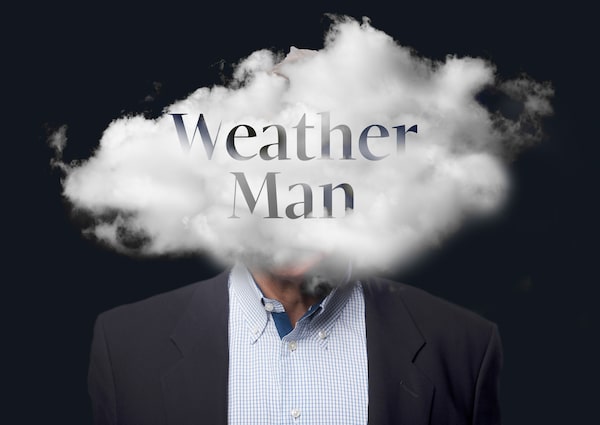
It is easy for an average curious person (without mentioning any names) to slide down the rabbit hole known as the Daily Data Report. The Daily Data Report is one of the blossoms on the Historical Data tree growing within the federal government’s rich garden of weather statistics.
For instance, the average mean temperature in Toronto for April, 2018 – the month that just ended, and that has transmuted so instantly hereabouts into summer – was 3.4 C. That’s the lowest mean average April temperature recorded for the past five years. 2016 came closest, at 4.8; 2013 was torrid by comparison, at 20.6. April is obviously a variable month, sitting as it does on the shoulder of spring (which is why your grandmother told you not to plant your annuals until May 24). But April this year was cold.
Even so: Toronto’s response to the ice storm that briefly gripped central Canada the weekend of April 14 confirmed the general impression in the rest of the country that, weatherwise, the self-appointed Centre of the Universe is a collection of hysterics.
I mean: the police told everyone to stay indoors. Need we say more? The brunt of the storm lasted less than 36 hours. A tiny percentage of people lost power for a stretch and 1,600 automobile collisions occurred, or about one every 10 minutes at the height of the action, but they were mostly fender benders. Yet Mayor John Tory, following in the Chicken Little tradition of his predecessor, Mel Lastman (who once begged the Armed Forces to shovel his city out of a blizzard), chose not to clear the roads at first for fear of the looming nightmare of “ponding.” Ponding happens when plowed slush blocks sewer grates and can lead to flooding, which since Hurricanes Katrina and Harvey has become a serious public relations nightmare for city administrations. By the time some ice sheared off the CN Tower and lightly punctured the roof of Rogers Centre, necessitating the rescheduling of a baseball game (itself lamented as a hardship), the newspapers (this one, at least) were referring to the “massive” ice storm that “ravaged” the province. By then the disaster was melting away.
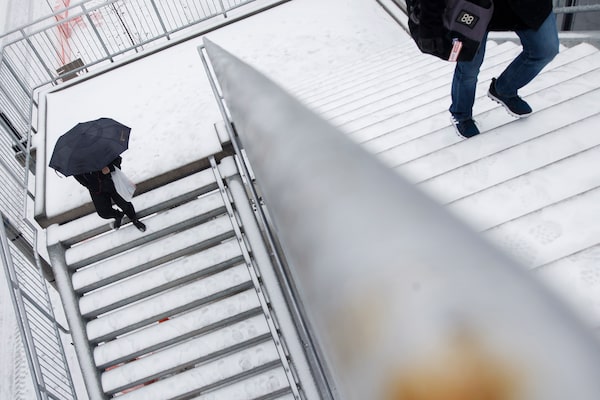
People walk up and down snow covered stairs during a spring storm in Toronto on April 14, 2018.COLE BURSTON/The Canadian Press
The mayor’s mistake, judging by the whining from members of his council, was that he conveyed the impression that city hall could somehow control the consequences of the storm. And it was an impression we were collectively willing to lap up. Why not? We live in the age of the weather app, a surprisingly pervasive technology designed to convince us we can control the uncontrollable. It’s a delusion with consequences.
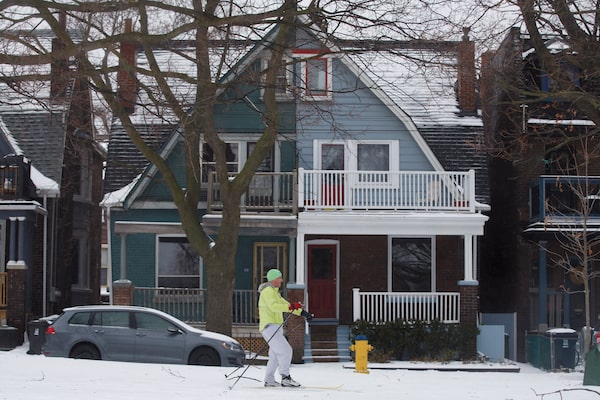
A man cross-country skis past houses on the edge of Trinity Bellwoods Park in Toronto as a mix of snow, hail and rain falls on April 15, 2018.COLE BURSTON/The Canadian Press
A man slips on an icy snow-covered sidewalk as freezing rain falls in Toronto on April 14, 2018.HYUNGWON KANG/Reuters
I was in no danger of making the same error, for once, because I spent the week before the storm being tutored in the unpredictability of weather forecasting (as opposed to modelling climate change, which is a very different matter) while backcountry skiing with a group of pals in the Selkirk Mountains in south-central B.C.
The weather in the mountains at 1,600 metres wasn’t great – the sun came out, in any kind of decisive way, no more than four times in seven days – but we skied regardless, under a sky that looked like a giant steel wok. Our guides, John Everts and Bryon Wedell, two guys in their thirties who seemed to find almost everything amusing, had an InReach transmitter that sends and fields texts via satellite. Mr. Everts got a daily texted weather report from his girlfriend Cat, who was keeping an eye on the Internet weather from the town of Revelstoke, roughly 50 kilometres to the west. Even so – and I say this as a technically overarmed city slicker prone to checking his weather app prior to taking a taxi downtown – Mr. Everts and Mr. Wedell treated this bootlegged weather news with the same skepticism you might a well-meaning but wayward father: fun to have around, provided he shows up.
There’s an old saying in the mountains: if you don’t like the weather, wait 15 minutes. One evening Cat’s texted forecast predicted the arrival of 20 centimetres of snow the following day. The skies above our hut were clear that night, and Mr. Everts thought snow was unlikely. Twenty-four hours later, the clouds were still spewing white stuff. But another day, when Cat’s official weather report anticipated subzero temperatures and a blizzard, the weather instantly became warm and clear and gloriously sunny – the best skiing of the week. We climbed up from the hut onto the outlying ice of the Billy Whiskers Glacier and skied down the other side of a pass and then skinned back up and carved our way downhill home, happily exhausted and utterly unweathered. In the mountains, sunshine makes everyone eager. Snow feels like a tranquillizer. Rain is the most unwelcome element, because if you get wet, and you inevitably do, you get cold when you stop. On our second day, rain fell for five hours, uninterrupted.
“The thing about the weather,” Mr. Wedell said later – he may be the most optimistic person I’ve ever met – “it’s just a forecast. We subscribe to a weather product for snow professionals, and it’s basically a meteorologist who sits in a room and compares general weather models, and decides what he’s going to pay attention to.” In the mountains, he says, weather predictions are more often wrong than right. “There’s so many microclimates. So you just have to adjust to the conditions.” Guides in the Rockies dismiss the official Environment Canada weather report as “typically true only for valley bottom.”
In the mountains, there is no pretense of having any control over the weather, or over much else. It’s a strangely liberating experience, one I’d like to recommend.
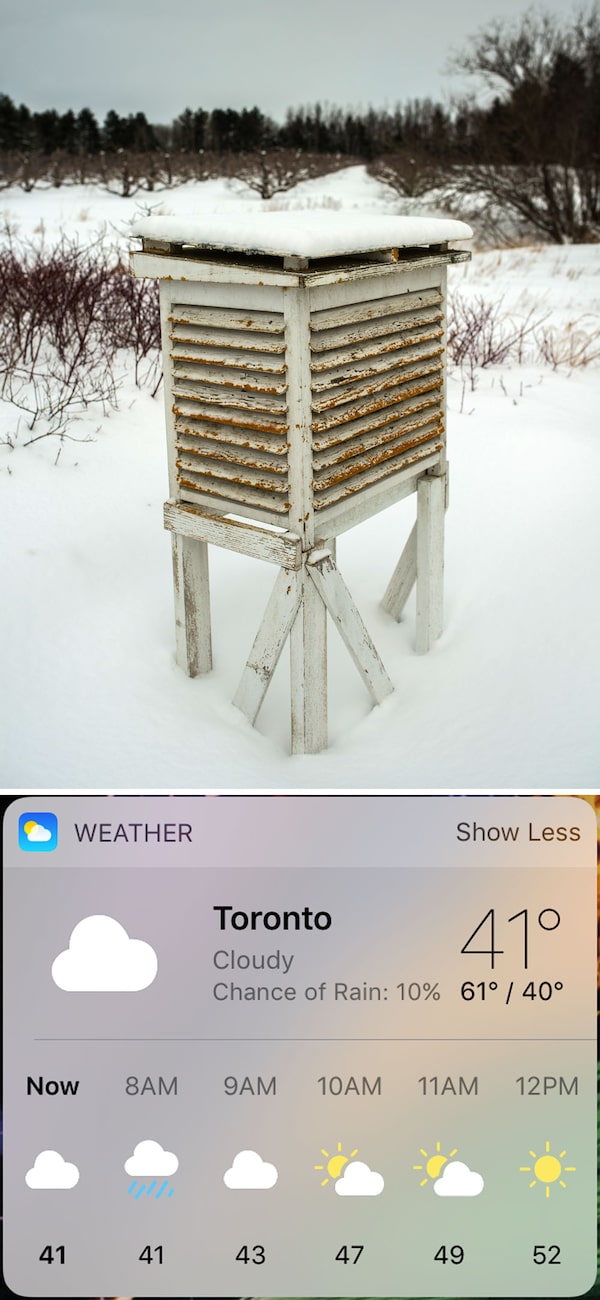
Weather forecasting's past and future: At top, a Stevenson screen, a wooden box to shelter meteorological instruments, stands in rural Nova Scotia; at bottom, the weather app on an iPhone.Brad Spicer Photography, The Globe and Mail
Forecasting’s folly
The main impediment to abandoning one’s compulsion to know what the weather is going to do is your smartphone’s weather app, a gizmo that gives you an illusion of exactitude in a realm where consistent precision is simply not possible. Nonetheless, predicting the weather (as opposing to knowing it) is now a $6-billion-a-year industry in North America.
Long gone are the days when the only way to forecast the weather was via a network of Stevenson screens across the country. A Stevenson screen is a weather station that looks like a white louvred wooden beehive perched about two metres off the ground. It was designed in the mid-1800s by the Scottish civil engineer Thomas Stevenson, who was also the father of Robert Louis Stevenson, who wrote Dr. Jekyll and Mr. Hyde, which in a way is a book about two very different weather systems.
Dedicated weather weenies all over the country took local readings behind their Stevenson screens – temperature, relative humidity, atmospheric pressure and the like – and then mailed or telegraphed or (later) phoned and e-mailed the data in to the federal government’s weather offices. (They still do, in many places.)
Percy Saltzman, Canada’s first television weatherman, had a Stevenson screen in his backyard. That was a decade before he persuaded the CBC to let him draw the weather on a blackboard map with a big piece of chalk in 1952. (He was paid $10 an appearance, and kept his job at the Dominion Weather Service until 1968: he wasn’t sure TV would last). His first big weather story was Hurricane Hazel, which hit Toronto in 1954.
Back then, weather forecasting had a human, hands-on, and therefore fallible feel: People collected current measurements and meterologists such as Mr. Saltzman, armed with that data and historical records and statistical tables, made an educated guess as to what was going to fall out of the sky the next day. Mr. Saltzman was a hit because people found him reassuring, a hedge against the unpredictability of most daily life. When viewers ran into him in the street, his son Paul Saltzman told me the other day, “they told him they considered him part of their families.” At home he was a withdrawn and often angry guy; on TV, he was the human expert who calmly and convivially told you what to expect in an otherwise capricious world.
Today, private weather-forecasting businesses and their apps base their predictions on weather data and models made publicly available by governments – governments being the only entities that can afford large-scale radar and satellite infrastructure, most of which is dedicated to public safety and defence. (Ulysses Grant started the U.S. weather service as a division of the department of war). The private companies then add their own proprietary information and sell their weather products to specific users – farmers (rainfall), truckers (wind analysis), golfers (anything that might lower their scores).
Each app claims its info is more revealing than anyone else’s. Weather Underground, for instance, relies on publicly available weather models, augmented by more than 250,000 local weather readings. The Weather Channel app uses IBM machine-learning tools to assess data from a wide array of weather prediction models. Accuweather, a vast “weather media” company and app maker, claims to have the most accurate estimates of the economic toll of an oncoming storm.
In the Rockies, without electronic aids, our guides went old school, which sounded a lot like what happens in my house in Toronto. “You get up in the morning, you look out the window,” Mr. Wedell said. “Then you walk around outside to see how much snow has fallen. Then you look at your watch.” Their watches are also altimeters, which measure air pressure and thus triple as barometers. If you wake up and your watch says you are 50 feet lower than you were when you went to bed, the atmospheric pressure has risen, and the weather will get better in four to six hours. All of this tells you what is going to happen to the snow pack, which helps you understand the avalanche potential. “It’s probably not as accurate as the full weather report,” Mr. Wedell said. But it was just as effective.
But while in the city I compulsively consult my four (four!) weather apps, they rarely tell me more than I learn standing on the back porch and feeling the air and reading the thermometer. True, if those apps say there’s an 80-per-cent chance it will rain late in the afternoon, I stuff rain pants in my satchel for the ride home. An 80-per-cent chance I trust. A 20-per-cent chance of rain I do not trust, because I know there exists a “wet bias” – the (often intentional) tendency of commercial weather apps to inflate relatively slim chances of precipitation (say, 5 per cent) to larger percentages ( say 20 per cent). They do this for a reason: if the weather app predicts rain and it doesn’t rain, everyone is thrilled. If the app predicts only a slim chance of rain, and it rains anyway, everyone blames the app.
Claude Monet always went outside in bad weather: He wanted to see how weather affected the view, how it changed the way he felt as a human being. We often use weather apps to do the opposite – to avoid going outside, to avoid the uncertainty of speculating and the complex anxiety of being human. Weather technology pretends it can eliminate surprises, which is possibly why we become so irrationally hysterical if the forecast doesn’t go as planned (ponding! ravaging!). My brother-in-law, an intelligent engineer-turned-lawyer, has the MyRadar weather app on his phone, which he consults regularly. “It’s got a Doppler for the whole world,” he explained. “So you can spin around the entire globe and see the Doppler, see the rain coming in on the radar.” He admits this is not useful in any way, but does it regardless, because it appeals to the scientist in him – to his hunger for a hypothesis. But even if the app says rain, he never bothers to take an umbrella: “I drive my car, and I park in an indoor garage at both ends.” And he lives in California.
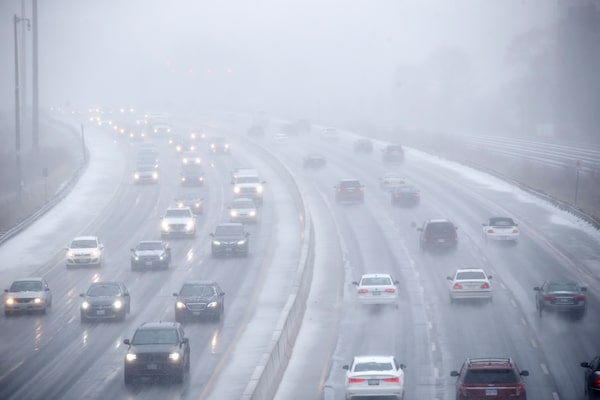
Cars drive along Toronto's Lake Shore Boulevard as visibility diminishes through falling hail, snow and rain on April 14, 2018.COLE BURSTON/The Canadian Press
It is true that technology has made us slightly better weather predictors (and much better modellers of climate change). Our high temperature forecasts are closer by 50 per cent now than they were in 1972: We’re only three rather than six degrees off, on average, according to Nate Silver, the FiveThirtyEight statistician and author of The Signal and the Noise, a book about the difficulty of forecasting. An American’s chances of getting killed by lightning are now one in 11 million, versus one in 400,000 in 1940, thanks to better weather warnings. The average prediction for where a hurricane will make land is now only 160 kilometres off target.
But it often seems that the more time we spend collectively trying to predict something, the less likely it is that thing can be effectively predicted. (When experts say something is an absolute certainty, Mr. Silver insists, they are statistically completely wrong about a quarter of the time.) We don’t seem to be able to predict the economy (one in 500 economists foresaw the wipeout of 2008), or earthquakes, or elections (ask Hillary Clinton and James Comey) or sporting outcomes (hence the betting industry’s huge profits).
And despite what the weather enterprise industry claims, we still can’t predict the weather reliably. For one thing, weather tends to be hyperlocal: It’s much easier to predict what will happen tomorrow in California, where weather is fairly stable, than it is in Oklahoma, where change is a constant. In one experiment in Kansas City, on the days when a 100-per-cent chance of rain was forecast, it did not rain at all a third of the time. That’s a huge margin of error. And when weather forecasts do work, they can still be maddeningly vague. Way back in January, Environment Canada predicted Toronto would have a cold, wet, icy spring. Don’t say nobody told you about that ice storm. They just didn’t say when it was coming, so it felt more random.
“There’s more weather models out there, and there’s more telemetry out there,” Mr. Wedell said. “But you still need to be able to extrapolate from that. Because you never know what’s going to happen. Because it’s the weather.” And he means the weather even without the role of climate change, which is driving it to greater extremes. “The feeling now in the guiding community,” he added, “is that there’s no normal anymore.”
This morning, as I began to type this paragraph, the National Oceanic and Atmospheric Administration’s weather app on my phone informed me it was 18 C outside. The Weather Network, the one that uses IBM machine learning, said it was 12. That’s an entire overcoat of difference. Had I stepped outside and trusted my body, I would have known instantly how cold or warm it was, and how I needed to dress.
A few hours after leaving home, I called Tom Raudaschl, another old pal and guide in the Rockies. He’s been at it for 35 years. He was in Spain, taking a break from skiing. “The Spanish say hablar del tiempo es perder el tiempo,” Tom said. “Weather and time is the same word, so I think it means talking about the weather is wasting time.”
The weather is the weather, in other words, an unavoidable form of existential present, a reality we have the gift of confronting every day of our lives. Reading about it on an app is one thing. Experiencing it firsthand – on a mountainside, or on a treacherous sidewalk, with your umbrella still uselessly at home in its stand – is another adventure entirely The adventure reminds us sharply how little we know – especially about what the future will bring.
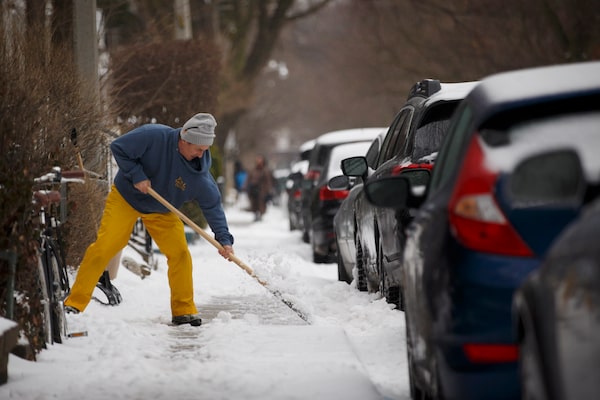
Stefan Randstrom clears ice from his sidewalk in Toronto as a mix of snow, hail and rain fall on April 15, 2018.COLE BURSTON/The Canadian Press